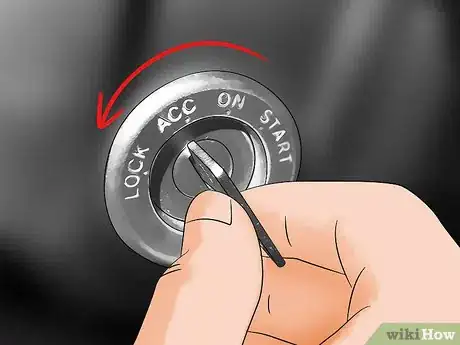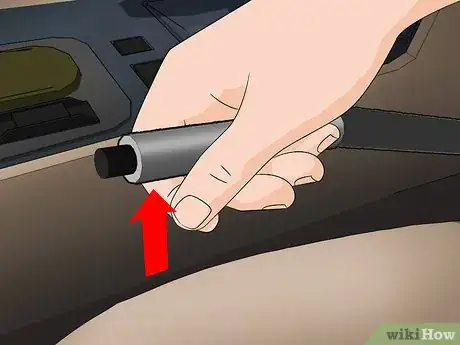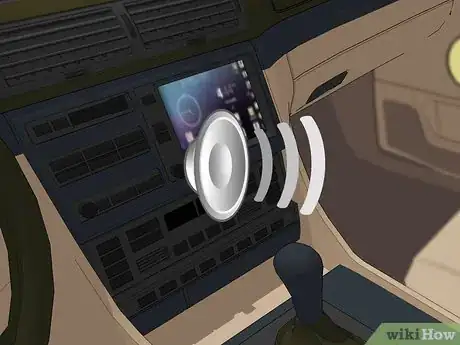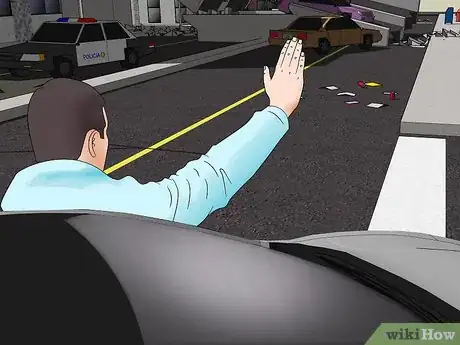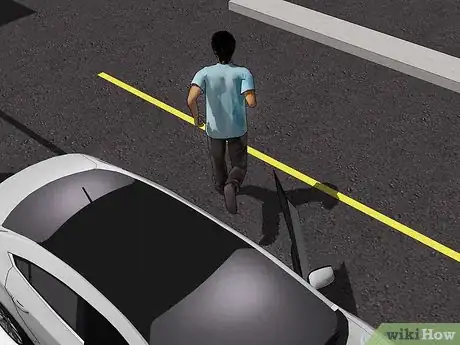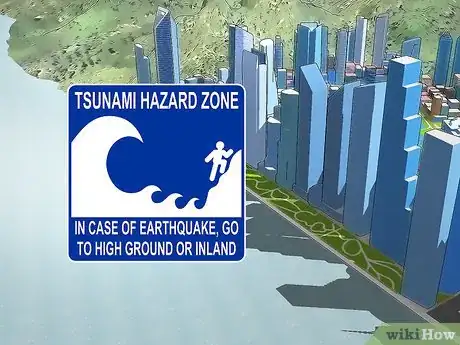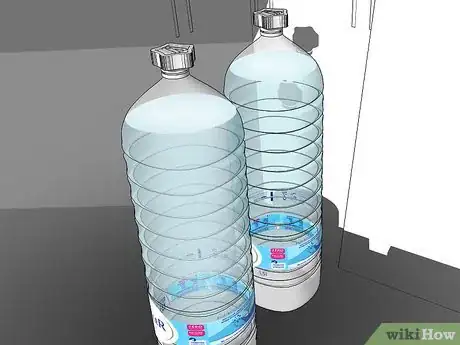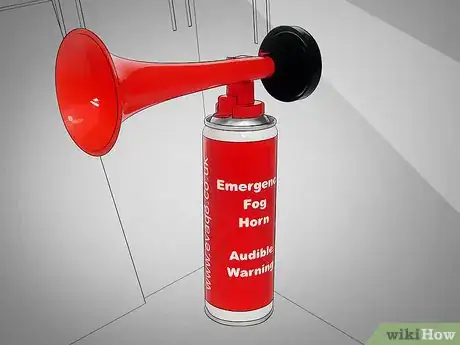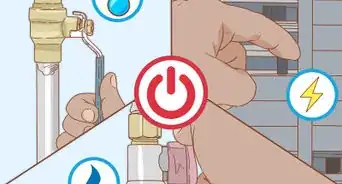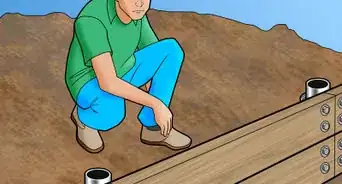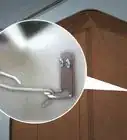This article was co-authored by wikiHow Staff. Our trained team of editors and researchers validate articles for accuracy and comprehensiveness. wikiHow's Content Management Team carefully monitors the work from our editorial staff to ensure that each article is backed by trusted research and meets our high quality standards.
This article has been viewed 101,266 times.
Learn more...
Earthquakes are dangerous natural disasters that occur every year. If you live in a region prone to earthquakes, you might at some point find yourself in your car when one strikes. Depending on the circumstances, this could present a variety of challenges to you. Ultimately, by parking your car in a safe location, reacting to the earthquake as it happens, and preparing in advance with an earthquake survival kit, you’ll stand a better chance at surviving in your car.
Steps
Parking Your Car
-
1Pull over to the shoulder. If you’re driving when the earthquake strikes, you should pull over to the shoulder of the road in a quick and safe manner. This is important, as you don’t want to be struck by other motorists who are trying to flee the area.
- Make sure to signal and/or turn your hazard lights on.
- If you are on an overpass, wait until you are on solid ground before you stop.[1]
-
2Look for a location where things can’t fall on your vehicle. As you’re trying to pull over, you should look around for a spot where your vehicle will be safe from falling debris. If you’re in the middle of a city, you may not have many good options. In this case, you may just want to park your car in a place you are most comfortable with.[2]Advertisement
-
3Park your car away from expansion joints on an elevated highway. If you find yourself driving on an elevated road during an earthquake, find a safe location to park your vehicle away from the joints of the highway. This is important, as the concrete slabs of the highway could fall off their supports during the earthquake.[3]
-
4Turn off your engine. After you park your car, you should turn the engine off immediately. This is important, as the earthquake could damage your vehicle or rupture the gas tank – creating a situation where your car catches fire or even explodes.[4]
-
5Put your emergency brake on. Once your engine is off, put your emergency beak on. Your emergency break will help keep your car from rolling backwards or forwards if the ground becomes unlevel below the vehicle. This is especially helpful if you‘re on a bridge or elevated road, where your car could roll off.[5]
Waiting for the Earthquake to End
-
1Switch on your radio. Once the worst of the earthquake has subsided, turn your radio on and search for a news station. The station will likely broadcast valuable information about the extent of the earthquake, evacuation routes, rescue efforts, and instructions for people hurt or trapped by the event.[6]
-
2Stay in the vehicle and assess the situation. While you may be tempted to jump right out of the car after the earthquake is over, unless it is an emergency, you should stay a moment and look around. If the earthquake was minor, and you think you can safely drive away, do so – but be careful. When assessing the situation, pay attention to:[7]
- Downed powerlines around you.
- The condition of the road around you.
- Whether other people are getting out of their cars.
- If you smell gasoline or natural gas.
- Whether your vehicle is damaged or not.
-
3Alert others if you need assistance. If you are injured or trapped in your vehicle, alert others immediately. You can do this by waving to people, shouting, or using a noise-making device from your survival kit. With a little luck, someone will quickly come to your aid.
-
4Get out of your car if you smell gasoline. Whether you are in the middle of an earthquake or afterwards, you should exit your car immediately if you smell gasoline. This is important, as your car could potentially catch on fire or even explode.[8]
-
5Leave your car if you hear a tsunami alert. If you’re near water and hear a tsunami alert, you should leave your car and run at least 0.5 miles (0.80 km) inland or at least 100 feet (30 m) above sea level. You’ll likely be safer higher up than trying to flee in your vehicle.
- If that is not an option, then run to an evacuation tower. These towers are located in low-lying coastal areas where moving inland is impossible. Get as high as possible, and be prepared to move further up the tower. If the tower is at a public building, note that the walls of the building are designed to break away to allow water to flow through, but the tower will remain standing.
Creating an Earthquake Survival Kit
-
1Find a container to house your kit. Depending on the size of your car and what you choose to include, you can pick from a number of receptacles to store your kit items. The item you pick should be sturdy and big enough to hold everything you want. In addition, you should be able to organize your items in it.
- Some possible items include large buckets, a cloth/canvas grocery bag, an old suitcase, or a large plastic storage container.
- Depending on the size of your kit, you'll probably have to store your water outside of it.
-
2Store water in your vehicle. Perhaps the most important element of your survival kit is drinking water. If you find yourself trapped in your car, it may be hours or even days until rescue workers reach you. During that time, you’ll need water to survive. Pack as much as you can.[9]
- Avoid storing water in your trunk, as you may not be able to access it in some circumstances. The closer and more accessible your water, the better.
-
3Pack food into your kit. Include as much high-calorie food in your survival kit as you can. While space might be an issue, chances are you can find food that takes up minimal space but has a lot of calories. You may need the calories if you’re stuck in your car for a prolonged period.[10]
- Energy bars are a great option to include in your survival kit, as they have a lot of calories and will last a long time.
-
4Include a foghorn or noise-making device. If you find yourself stuck in your car, you may need to make noise to alert rescue workers. In this case, the louder your noise-making device, the better. Ultimately, this is an essential piece of your car earthquake survival kit.[11]
- Cover your ears or use ear plugs when you use your noise-making device.
- Point the noise making device away from you, and out a window if possible.
-
5Get a flash light. If your vehicle is completely covered under rubble or debris, it may be completely dark. If this is the case, you’ll need a flash light to help determine your situation, use other parts of your survival kit, or to signal rescuers.[12]
- Include extra batteries for your flash light.
-
6Expand your kit to include other items you think you need. In addition to the basics, there are many other items you might consider including in your kit. These items include food, communication items, and first aid items. View this list for more ideas on what to include.
Community Q&A
-
QuestionWhat happens if I get stuck in my car?
 Community AnswerUse your cell phone to call for help. If that's not an option, wait till the shaking subsides, and see if there's any you can use to shatter your window and climb out.
Community AnswerUse your cell phone to call for help. If that's not an option, wait till the shaking subsides, and see if there's any you can use to shatter your window and climb out. -
QuestionWhat can I do to prevent an earthquake?
 Community AnswerAn earthquake is a tremor caused by the plates underneath us moving and sliding against each other; that is why earthquakes are always on fault lines. Fault lines are the edges of where those plates meet. An earthquake cannot be prevented -- humans cannot dictate the Earth and its natural movements.
Community AnswerAn earthquake is a tremor caused by the plates underneath us moving and sliding against each other; that is why earthquakes are always on fault lines. Fault lines are the edges of where those plates meet. An earthquake cannot be prevented -- humans cannot dictate the Earth and its natural movements. -
QuestionWhat happens if I am stuck under a bridge during an earthquake and there is traffic?
 Community AnswerExit the car and lay close and flat to the driver's side door. If the bridge collapses, the "pancake" effect the car might encounter could protect you from the bridge debris and hopefully will not collapse the car all the way to the ground, leaving you a safe zone.
Community AnswerExit the car and lay close and flat to the driver's side door. If the bridge collapses, the "pancake" effect the car might encounter could protect you from the bridge debris and hopefully will not collapse the car all the way to the ground, leaving you a safe zone.
Things You'll Need
- Flashlight
- Batteries
- Gallons of water
- Food
- Noise making device
- First aid kit
References
- ↑ http://www.lamag.com/driver/caught-in-the-quake-what-to-do-if-you-are-driving-when-an-earthquake-strikes/
- ↑ http://www.topgear.com.ph/features/tip-sheet/how-to-survive-an-earthquake-while-you-re-inside-your-vehicle
- ↑ http://www.topgear.com.ph/features/tip-sheet/how-to-survive-an-earthquake-while-you-re-inside-your-vehicle
- ↑ http://www.lamag.com/driver/caught-in-the-quake-what-to-do-if-you-are-driving-when-an-earthquake-strikes/
- ↑ http://www.lamag.com/driver/caught-in-the-quake-what-to-do-if-you-are-driving-when-an-earthquake-strikes/
- ↑ http://www.lamag.com/driver/caught-in-the-quake-what-to-do-if-you-are-driving-when-an-earthquake-strikes/
- ↑ http://www.lamag.com/driver/caught-in-the-quake-what-to-do-if-you-are-driving-when-an-earthquake-strikes/
- ↑ http://www.topgear.com.ph/features/tip-sheet/how-to-survive-an-earthquake-while-you-re-inside-your-vehicle
- ↑ http://www.latimes.com/la-me-disaster17sep17-side-htmlstory.html



